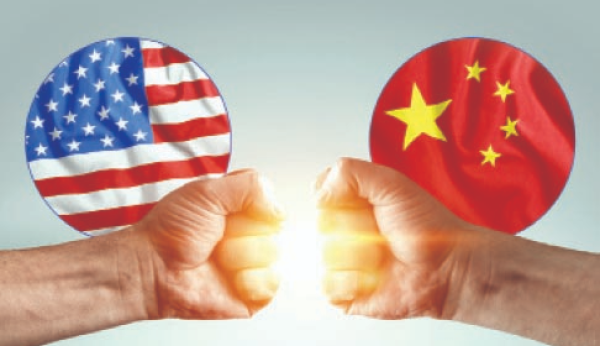The Rise of China and the Shifting Global Power Dynamics
The Rise of China and the Shifting Global Power Dynamics
The Rise of China and the Shifting Global Power Dynamics

The recent ascent of China has been truly remarkable, propelling the nation from a struggling agrarian society to a global economic powerhouse. This rapid transformation has not only reshaped China but has also significantly impacted global power dynamics, challenging the traditional dominance of the Western world. China has pursued a clear mission and vision, strategically positioning itself for both short-term and long-term success. China has made undeniable progress on a number of fronts, particularly in the areas of the economy, military, and technology, which highlights its expanding influence on the global stage.
What factors have contributed to China’s expanding global presence? How has Beijing employed strategies to bolster its position internationally? Does China employ consistent approaches in different regions or countries? Why have other major powers struggled to deter smaller and weaker nations from aligning with China? Lastly, what pivotal role has Beijing assumed in reshaping global power dynamics? This analysis seeks to briefly explore these research questions to elucidate China’s ascent in the global order and its impact on shifting global power dynamics.
The rise of China and major powers
China’s remarkable success across various spheres of global power—politics, economy, and technology—has been the result of a strategic and gradual process. Leadership, considered a crucial element in a nation’s overall success, played a pivotal role in China’s ascent. The transformative phase initiated in 2013 under Xi Jinping’s leadership marked a significant shift in China’s foreign policy, aligning with the vision to achieve the “China dream.” Central to Xi Jinping’s policies has been a focus on prosperity and wealth, with elements of a personality cult reminiscent of Mao. The overarching goal has been to position China as a global superpower, surpassing the US economy, and expand its influence through initiatives like the One Belt, One Road (OBOR), later rebranded as the Belt and Road Initiative (BRI).
China’s rise to prominence can be attributed to a confluence of factors, including its vast population, rapid industrialization, and strategic economic planning. By prioritizing export-led growth and investing in critical sectors such as technology and manufacturing, China has emerged as the world’s second-largest economy, surpassing established powers like Japan and Germany. This economic prowess has translated into increased political influence on the global stage, with China adopting a more assertive stance in advancing its interests regionally and globally. The ambitious Belt and Road Initiative exemplifies China’s efforts to extend its economic footprint across continents, reshaping global trade dynamics. Moreover, Beijing’s push to reform international governance structures reflects its aspiration to challenge the traditional dominance of Western powers in key institutions like the United Nations and the World Trade Organization.
China’s intention to surpass Western powers, particularly the United States, in technology and military capabilities is a key aspect of its strategic vision. Beijing’s leaders are resolutely focused on enhancing their military prowess, not only on land but also in space. According to Yuri Borison, the head of the Russian Space Agency, China is actively involved in ambitious projects like placing a nuclear power unit on the moon by 2033–2035 in collaboration with major powers like Russia and Iran. Additionally, joint efforts with Russia in developing advanced drones like the “Shahed-136 Kamikaze drone” indicate China’s strategic alignment with its partners to advance its cyber security programs at a pace outstripping their Western counterparts.
The rise of China has reshaped the balance of power in South, Southeast, and East Asia, leading to a widening power gap between China and other regional powers such as India and Japan and altering regional dynamics. China’s increasing military capabilities and assertive stance in territorial disputes have raised concerns among neighboring countries, prompting a strategic realignment towards strengthening ties with the United States as a counterbalance to Chinese influence. The region has witnessed heightened tensions due to China’s growing influence and territorial ambitions, necessitating a recalibration of regional alliances and security arrangements.
In response to China’s ascent, Western countries have adopted diverse strategies, from engagement to containment, to manage its growing influence. The United States has taken a confrontational approach, viewing China as a strategic competitor and potential threat to its global dominance. By forming regional alliances like QUAD in the Indo-Pacific, Western powers aim to counterbalance Chinese influence. However, the economic leverage China provides to third-world nations through investments, aid, and loans has hindered the effectiveness of these anti-Chinese blocs, making it difficult for Western efforts to contain China’s rise.
The emergence of new powers like China also presents challenges in various regions, particularly in Asia, where competing spheres of influence create an unstable equilibrium and compel smaller states to align with either side. This dynamic foster uneasy coexistence rather than regional solidarity, highlighting the complexities of navigating the rise of emerging powers and their impact on regional dynamics.
China’s contribution to changing global power dynamics
The shifting global power dynamics brought about by China’s rise pose both challenges and opportunities for many other major powers. On one hand, China’s economic growth has lifted millions out of poverty and contributed to global prosperity. On the other hand, its increasing assertiveness, overt and covert influences, and interference in many smaller countries’ internal affairs, as well as its own version of politics and domestic and foreign policies, have raised concerns among the international community about its intentions and the stability of the international order. This has sparked discussions on the shifting balance of power from West to East, with emerging powers like India, Brazil, South Africa, and Turkey gaining influence and challenging the dominance of traditional powers. Regionalism has also played a key role in shaping world power dynamics, with organizations like the EU, ASEAN, AU, and GCC fostering cooperation among neighboring countries to reduce dependence on external actors.
In this evolving global order characterized by multipolarity and regionalism, China’s influence has grown significantly compared to other major powers like the United States. Chinese economic engagement with the world now surpasses that of the US in certain regions, with substantial investments in FDI, loans, and aid. Despite challenges in obtaining accurate data on Chinese financial engagements, estimates suggest that China’s economic footprint has more than doubled in the past decade. This trend is particularly evident in Asia and Africa, where Beijing’s investments have been instrumental in bolstering its political influence. As China continues to expand its economic reach globally, it is reshaping traditional power dynamics and challenging established norms in international relations.
China’s massive influence in the current world order, characterized by multipolarity and regionalism, is evident in the significant increase in the country’s engagements compared to other key powers, including the United States of America. Chinese economic engagement with the rest of the world surpasses that of the superpower, America, in certain regions. Despite challenges in obtaining accurate data on Chinese financial engagement, data from sources such as the Chinese government, the World Bank, and the IMF indicate that Chinese FDI, loans, and aid totaled approximately $205-260 billion in 2022, more than double the amount from a decade ago. China’s success in Asia and Africa, with estimated FDI, loans, and aid of $120–170 billion, has bolstered its political influence.
In terms of bilateral trade, China is increasingly closing the gap with the US, and in many regions, China’s bilateral trade surpasses that of the world power, America. In 2021, Chinese bilateral trade worldwide exceeded $4.6 trillion, while US bilateral trade reached $5.6 trillion. Specifically, US bilateral trade with Asian and African countries totaled around $1.9 trillion in 2021. In contrast, China’s bilateral trade with these continents amounted to over $1.7 trillion. Unofficial data suggests that Chinese bilateral trade in FY 2023–24 has seen a substantial increase compared to the USA.
An important feature of Chinese foreign policy and strategies is to enhance its engagement with numerous multilateral and regional organizations and associations. China’s bilateral trade with ASEAN, AU, and SAARC member countries has reached a peak from previous years. According to recent data, the total amount of China’s bilateral trade with ASEAN has significantly increased and become more than double in ten years. The total trade volume between China and ASEAN in 2021 amounted to $684 billion, showing substantial growth in trade relations between the two entities. Similarly, the trade volume between China and the African Union and SAARC member countries has also doubled in the last decade. While the bilateral trade of China with the EU has been growing at an increasing rate, the country’s trade relations with the GCC countries have significantly increased—almost double in a few years. Thus, Chinese engagement not only in trade and commerce but also in specific country-wise and regional geopolitical issues in recent years has been a cause of shifting power dynamics.
The China-Russia-led BRICS has apparently been regarded as an anti-western bloc that is advancing with a number of key strategies and future plans, including launching a common currency for international payment to undermine dollars and euros in the global markets. The BRICS countries collectively represent a significant share of the world’s population, landmass, and economic output. As of 2021, the combined GDP of the group countries represents approximately 23% ($15.4 trillion) of the global economy. The collective influence of BRICS in global politics has been growing steadily. The group has advocated for a more multipolar world order and has called for reform of the United Nations Security Council to better reflect the current global realities and dynamics.
Another important tool for dominating the globe is cyberspace and technology. China has experienced massive improvements in cyberspace and technology in the past decade. Its contributions to the world in internet infrastructure, artificial intelligence (AI), 5G technology, e-commerce, digital payments, and space exploration have had a profound impact on global innovation, connectivity, economic development, and shifting global power dynamics. However, there are numerous risks of cybercrime occurring by both public and private companies in recent years, resulting in the making of laws in many developed and developing countries.
The ascent of China on the global stage has ushered in a complex interplay of opportunities and challenges for the international order. While China’s increasing influence contributes to a more balanced distribution of power worldwide, its expanding presence in strategically vital regions and its assertiveness in global politics and economics present potential threats to established hegemonic powers. The responses of anti-Chinese alliances could further exacerbate tensions in various regions unless addressed through collaborative efforts. As China continues to rise, it is crucial for policymakers around the world to engage with the country constructively while also standing firm on principles of democracy, human rights, and the rule of law. Striking a delicate equilibrium in managing competition with China will be crucial in shaping a secure and prosperous trajectory for the global community.
References:
1. Mahbubani, K (2020). Has China Won? The Chinese Challenge to American Primacy. New York: Public Affairs.
2. Paul, TV. (2019). When Balance of Power Meets Globalisation: China, India and the Small States of South Asia. Politics. Vol. 39, No. 1, pp. 50 - 63.
3. Ranjan, R. and Changgang, G. (2021). China and South Asia: Changing Regional Dynamics, Development and Power Play. New Delhi: Routledge.
4. Wagner, C. (2016), The Role of India and China in South Asia, Strategic Analysis, Vol. 40, No. 4, 307 - 320.
5. Raju, A. S. and Srinivasan, R. (2024). The Routledge Handbook of South Asia: Region, Security and Connectivity. London: Routledge.
6. Sumit, G; Manjeet, S. P; and William, R. T. (2023). The Sino- Indian Rivalry: Implications for Global Order. United Kingdom: Cambridge University Press
7. Bhatta, C. D. (2018). Emerging powers, soft power, and future of regional cooperation in South Asia. Asian Journal of Political Science, vol. 27, no. 1, pp. 1-16.
8. Prathiba, M.S. (2018). East Asia Strategic Review: China’s Rising Strategic Ambitions in Asia. New Delhi: Pentagon Press LLP.
9. Rahman, M.S. & Kubra, S.T. (2021). The Late 20th to Early 21st Century of foreign Policy of Bangladesh in Economic Dimension Towards China. Quantum journal of Social Sciences and Humanities. Vol 2, No. 1, pp. 72-83
 A. Hasan
A. Hasan 








